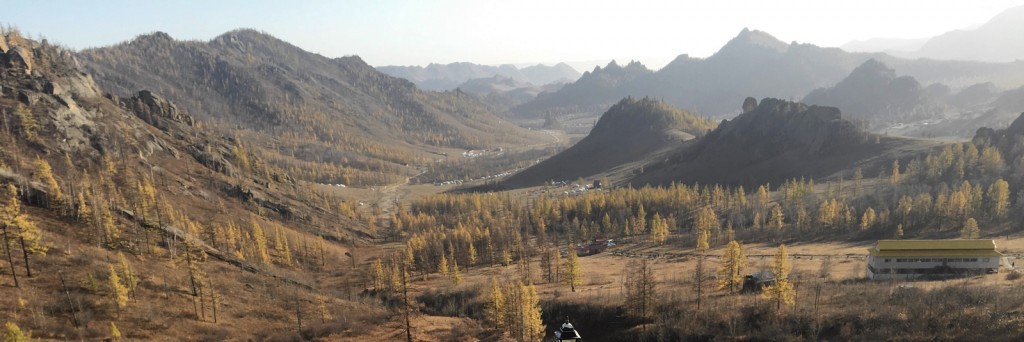
October 15, 2019
I wasn’t sure I would survive this one! I signed up for a day tour with Khuvsgul Lake Hotel’s Mobile Camper Tours the night before. My private tour included a van, a driver, and an English-speaking guide for ₮408,510, or US$153.00. 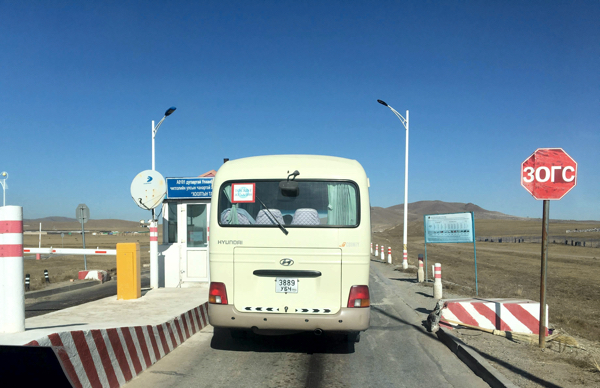 Plans included visiting the Genghis Khan Equestrian Statue, having lunch with a traditional nomadic family in their ger, a one-hour horseback tour in Terelj National Park, a stop at Turtle Rock, touring Ariyaval Buddhist Meditation Temple, and then finally, the 100-km drive back to the hotel through Ulaanbaatar’s evening rush hour traffic.
Plans included visiting the Genghis Khan Equestrian Statue, having lunch with a traditional nomadic family in their ger, a one-hour horseback tour in Terelj National Park, a stop at Turtle Rock, touring Ariyaval Buddhist Meditation Temple, and then finally, the 100-km drive back to the hotel through Ulaanbaatar’s evening rush hour traffic.
I met the tour guide, Inka, in the hotel lobby at 9:00 a.m. We hopped in the van, and were soon on our way out of the city. Inka pointed out important buildings and items/places of cultural interest on the way. It took a while to get out of the city; it was bigger than I thought. And, traffic was pretty heavy.
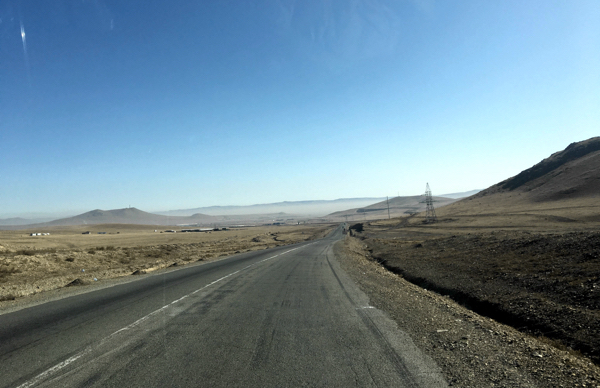 After about a half hour, traffic and buildings thinned, and we found ourselves heading out into the Mongolian countryside. It looks a lot like Eastern Washington with the grassy, treeless rolling hills. But, no tumbleweeds or scabland. Instead, gers. The countryside was dotted with the white Mongolian yurts, intermixed with stick-built and brick buildings. Shiny new 21st-century SUVs and trucks parked next to primitive gers seemed at odds with each other; modernity mixing with the nomadic lifestyle.
After about a half hour, traffic and buildings thinned, and we found ourselves heading out into the Mongolian countryside. It looks a lot like Eastern Washington with the grassy, treeless rolling hills. But, no tumbleweeds or scabland. Instead, gers. The countryside was dotted with the white Mongolian yurts, intermixed with stick-built and brick buildings. Shiny new 21st-century SUVs and trucks parked next to primitive gers seemed at odds with each other; modernity mixing with the nomadic lifestyle.
And, no I-90. Instead, the busy AH3 highway was a single lane in each direction. Broken down vehicles were frequent obstacles, and one drivers seemed to navigate without a second thought. I was glad I wasn’t driving as we sped along, squeezing between obstructions and on-coming traffic without hesitation. We went through a toll booth on our way out of the city, and Inka paid the ₮1,000 fee (US$0.37).
Genghis Khan Equestrian Statue Complex
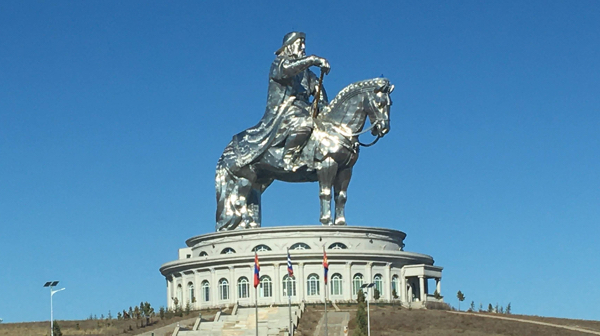 We drove through a number of smaller cities and villages and another toll booth, and about an hour later, reached our first destination: Genghis Khan Equestrian Statue (Chenghis Khan, in Mongolia). The statue of Mongolia’s greatest leader stands 40 meters high atop a two-story building and is made of stainless steel. It towered above us, gleaming in the bright morning sun. It was magnificent!
We drove through a number of smaller cities and villages and another toll booth, and about an hour later, reached our first destination: Genghis Khan Equestrian Statue (Chenghis Khan, in Mongolia). The statue of Mongolia’s greatest leader stands 40 meters high atop a two-story building and is made of stainless steel. It towered above us, gleaming in the bright morning sun. It was magnificent!
We spent about an hour exploring the complex, which houses a below-ground museum, first floor souvenir shops, and a second floor restaurant. The museum contained dioramas illustrating the evolution of Mongolian nomadic lifestyle, including gers. 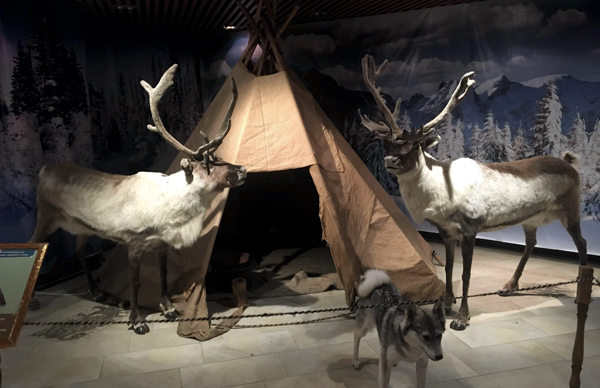 It was interesting to see how gers evolved over time, beginning with structures more resembling North American teepees. And, Inka did a great job pointing out and explaining the different exhibits, including the significance of the layout of ger living areas and nomadic family lifestyles.
It was interesting to see how gers evolved over time, beginning with structures more resembling North American teepees. And, Inka did a great job pointing out and explaining the different exhibits, including the significance of the layout of ger living areas and nomadic family lifestyles.
After making our way through the museum, we climbed the dark, narrow stairs to the horse’s head. The horse’s head was filled with visitors, so we waited our turn. After a brief wait, we were treated with a panoramic view of the surrounding steppes. The grounds around the complex have yet to be finished. At some point, the statue will be surrounded by 200 gers, arranged in the pattern of horse brands used by 13th century Mongol tribes.
We gawked at the view for a bit and then made our way back down to the ground floor, where I bought a couple of t-shirts for ₮20,000 each (US$7.50) and a small money pouch at one of the souvenir shops. The t-shirts, it turns out, are sized significantly differently from the US. They looked a little on the small size, so I bought the biggest size they had–3XL. I’ve NEVER worn 3XL in my life, and when I tried them on back at the hotel, they are still too small. 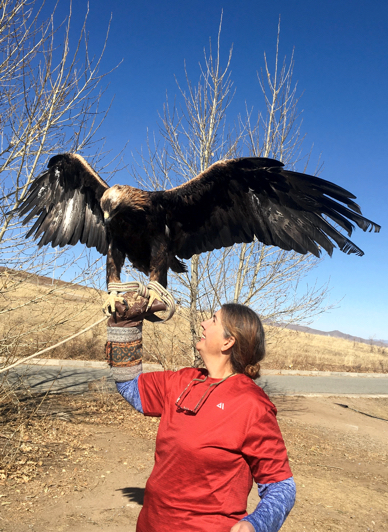 Normally, I wear a M to a L. Argh! A touristy Mongolian t-shirt was #1 on my must-have souvenir list; the search must continue!
Normally, I wear a M to a L. Argh! A touristy Mongolian t-shirt was #1 on my must-have souvenir list; the search must continue!
On the way back to the van, we stopped to take photos of a Mongolian hunting eagle. Her handler offered to let me hold her while I had my photo taken for ₮5,000 (US$2.00). I had my money out before he finished speaking. Two bucks for a chance to get up close and personal with a hunting eagle and get my photo taken? Sold!
That was fun! He told me to shake my arm up and down as I held her. She was really heavy, probably close to 15 pounds, and I had trouble lifting her. It was like trying to do an overhead press with a (live!) Thanksgiving turkey on my fist. She kept shifting her claws and flapping her wings while I struggled to do as her handler instructed. I think she stayed on my arm for only about a minute and a half, but that grin stayed on my face all day!
Gorkhi-Terelj National Park
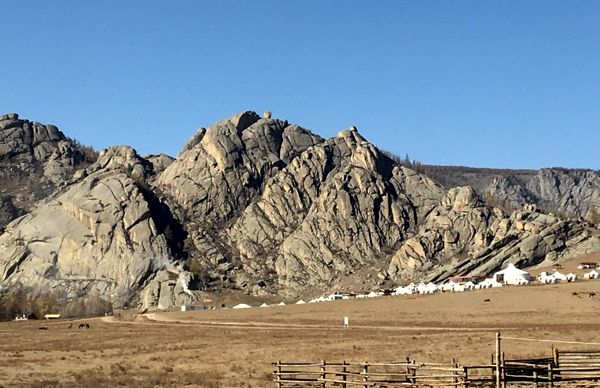 Next stop: Gorkhi-Terelj National Park to visit and have lunch with a nomadic family in their ger encampment, and then a one-hour horseback tour of the park. Because part of the highway was under construction and closed, we had to take a detour that added an additional 40km to the drive. More driving through the countryside and small cities and villages and two more toll booths until we turned onto a gravel road. Our host’s camp was not too far down and to the left.
Next stop: Gorkhi-Terelj National Park to visit and have lunch with a nomadic family in their ger encampment, and then a one-hour horseback tour of the park. Because part of the highway was under construction and closed, we had to take a detour that added an additional 40km to the drive. More driving through the countryside and small cities and villages and two more toll booths until we turned onto a gravel road. Our host’s camp was not too far down and to the left.
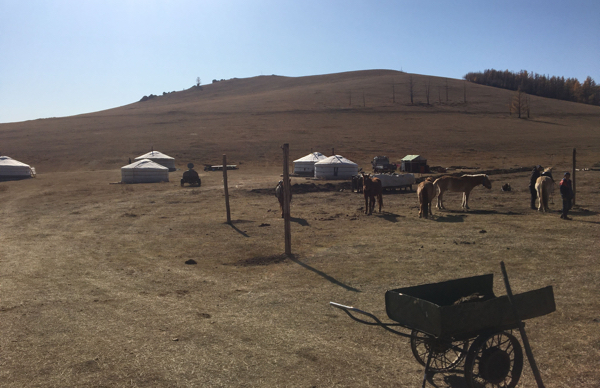 We pulled into the parking lot–yes, they had a grass/gravel parking lot with cement barriers–and walked over to their camp. The camp consisted of a collection of gers on cement foundations, a small blue outbuilding, and a corral. A four saddled Mongolian horses were tethered to a tie line, ready to go. A husband, wife, and son were hard at work on chores. They wore regular clothing, rather than the traditional Mongolian garb one might expect from a nomadic family. (I hesitate to refer to it as “western” clothing because it is pretty much standard apparel worldwide and heavily influenced by many cultures, including those outside the western hemisphere.)
We pulled into the parking lot–yes, they had a grass/gravel parking lot with cement barriers–and walked over to their camp. The camp consisted of a collection of gers on cement foundations, a small blue outbuilding, and a corral. A four saddled Mongolian horses were tethered to a tie line, ready to go. A husband, wife, and son were hard at work on chores. They wore regular clothing, rather than the traditional Mongolian garb one might expect from a nomadic family. (I hesitate to refer to it as “western” clothing because it is pretty much standard apparel worldwide and heavily influenced by many cultures, including those outside the western hemisphere.)
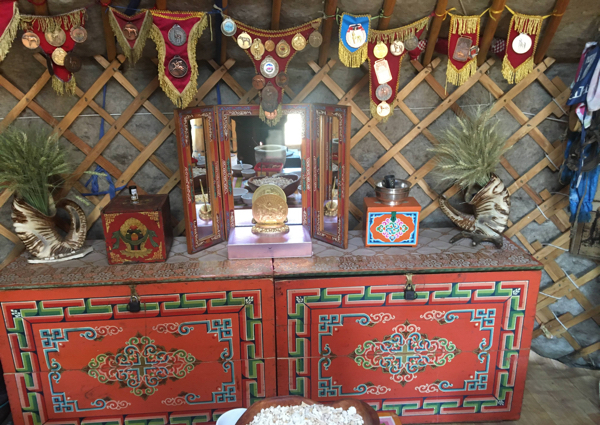 The hosts stopped what they were doing and invited us into their ger for lunch. I had to duck quite a bit to get through the door, which was probably only 4 1/2 feet tall. The interior of the ger was decorated with ornate furniture, lots of reds and golds. It was pretty typical of photos I’d seen and also stunning. Inka explained that the left side of the ger was for men and contained the husband’s bed, saddle, and other tools traditionally used by men, while the right side was for women and contained the wife’s bed and tools traditionally used by women. In between was a space reserved for an alter, although this family had none and instead used the space for decorations and sports medals won by male members of the family.
The hosts stopped what they were doing and invited us into their ger for lunch. I had to duck quite a bit to get through the door, which was probably only 4 1/2 feet tall. The interior of the ger was decorated with ornate furniture, lots of reds and golds. It was pretty typical of photos I’d seen and also stunning. Inka explained that the left side of the ger was for men and contained the husband’s bed, saddle, and other tools traditionally used by men, while the right side was for women and contained the wife’s bed and tools traditionally used by women. In between was a space reserved for an alter, although this family had none and instead used the space for decorations and sports medals won by male members of the family.
A very low table sat in the center of the room near the small wood stove, surrounded by small stools. The table was laid out with boortsog, ghee butter, khailmag, suutei tsai, and aaruul. I recognized a few of these from the hotel’s breakfast buffet, but I was unsure how to eat them.
The hosts, who spoke no English, indicated where I should sit and gestured to the food set out on the table. 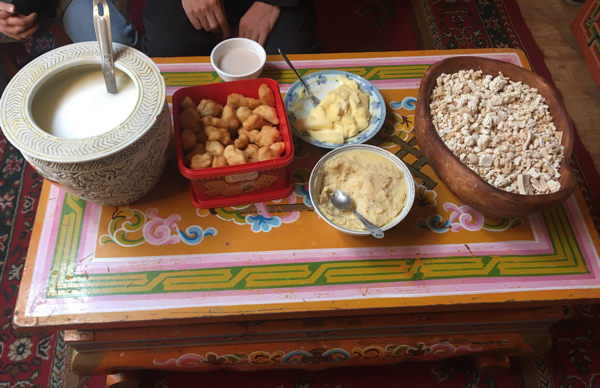 The husband sat silently with us at the table while the wife left. It was kind of awkward; I could only imagine how it must feel to have people pay to come into one’s home as if it were a zoo exhibit, but Inka assured me the family welcomed us. This was one of their jobs; they were used to it.
The husband sat silently with us at the table while the wife left. It was kind of awkward; I could only imagine how it must feel to have people pay to come into one’s home as if it were a zoo exhibit, but Inka assured me the family welcomed us. This was one of their jobs; they were used to it.
Inka instructed me on how to eat the meal laid out before us. I picked up a piece of the boortsog, Mongolian fried bread about the size of a popcorn shrimp, and tasted it. It was very dense and didn’t have much flavor. Inka suggested I try it with a bit of ghee butter. I’m not a big fan of butter, and the ghee tasted much like butter, but a less flavorful; not nearly as sweet or salty. I next tried boortsog with khailmag, a kind of caramelized clotted cream. It was pretty good! A little sweeter, a bit more flavorful, and a bit less fatty.
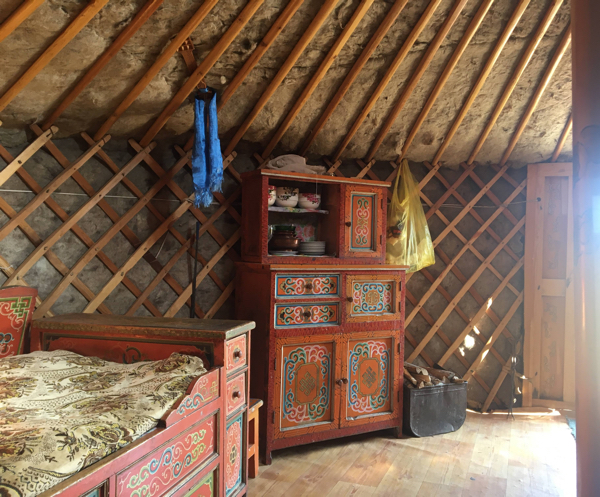 The suutei tsai, or milk tea was really good, as well, and I’m not normally a fan of adding milk to tea. However, rather than tea with milk, it was more like milk with tea. Or, the tea version of a latte. And surprisingly, the aaruul, a dried milk curd, was really tasty. It had a strong, tart flavor that I really liked, but it was teeth-breaking hard! I chewed a piece very carefully as the last thing I wanted was a broken tooth while on vacation in a foreign country.
The suutei tsai, or milk tea was really good, as well, and I’m not normally a fan of adding milk to tea. However, rather than tea with milk, it was more like milk with tea. Or, the tea version of a latte. And surprisingly, the aaruul, a dried milk curd, was really tasty. It had a strong, tart flavor that I really liked, but it was teeth-breaking hard! I chewed a piece very carefully as the last thing I wanted was a broken tooth while on vacation in a foreign country.
However, I was a little disappointed as the meal was pretty unsubstantial, especially by American standards. I’m more of a Happy Meal eater than a Super Size-It eater, so I don’t eat large lunches by any means, but this wouldn’t even stack up to a Happy Meal. I would have thought hard-working nomadic herders would need more calories for lunch than contained in a few pieces of fried bread with butter. Especially fried bread the size of a popcorn shrimp. Timidly, I asked Inka if this was it, and she laughed and explained the wife was out getting us the rest. Apparently, they don’t cook–or, at least, always cook–in the ger in which they live! One of their three gers must be for cooking; the other might be for their son.
With relief, I stopped shoving boortsog in my mouth and waited for the main course. A few minutes later, the wife walked in carrying bowls of beef noodle soup. It was delicious! Far better than the restaurant soup I’d eaten the day before. Big chunks of beef floated in a broth, along with large, squarish noodles. We quickly cleaned our bowls–the husband finished two bowls in the time it took us to each eat one!–and then it was time for the horseback tour. Before I left the ger, however, I photographed the inside, being sure to ask permission first.
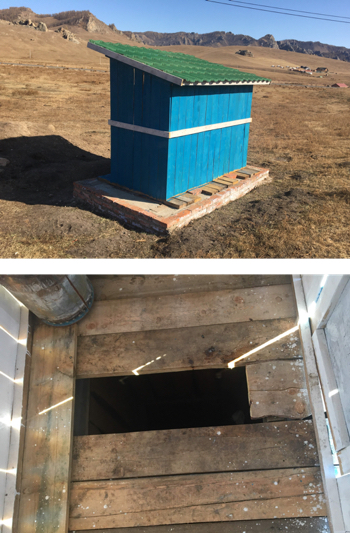 The horses and my 13-year-old guide were ready when we stepped out of the ger. But first–a visit to the little blue outbuilding. However, this blue outbuilding was not the same as the “blue rooms” we all so fondly love at Burning Man. Instead of sitting on toilet seats perched over chemical-laden holding tanks, we squatted over holes in the floor. I found myself wishing for a pee funnel as I delicately balanced myself, trying not to look down, while at the same time trying to ensure I didn’t miss. The “hole” was only a missing plank.
The horses and my 13-year-old guide were ready when we stepped out of the ger. But first–a visit to the little blue outbuilding. However, this blue outbuilding was not the same as the “blue rooms” we all so fondly love at Burning Man. Instead of sitting on toilet seats perched over chemical-laden holding tanks, we squatted over holes in the floor. I found myself wishing for a pee funnel as I delicately balanced myself, trying not to look down, while at the same time trying to ensure I didn’t miss. The “hole” was only a missing plank.
Business accomplished, and I went and met my horse. He wasn’t too impressed with me, and neither was my guide. Moreover, I can no longer mount from the left side, so I had to try from the right. I tried fruitlessly to drag myself up onto the saddle, but even my right leg wasn’t strong enough. It’s been almost four decades since I rode a horse! I felt the man put his shoulder under my butt and grab my hips, trying to boost me up. No go! This fat American ass was not getting on that horse the traditional way. The wife brought out a small stool, and that did the trick. Mongolian horses are not really horses–they’re ponies. I didn’t measure this little guy, but I could almost touch my toes under his belly. However, Inka assured me Mongolian horses can easily carry 150kg, and as I’m not quite triple digits.
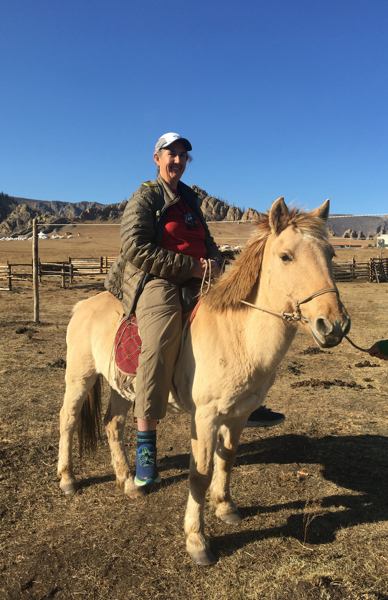 They couldn’t get the stirrups to go down far enough for my comfort, so off we went, with my legs dangling. With as many summers as I have spent galavanting around the countryside bareback as a kid, not having stirrups doesn’t bother me. But, being led around by a scowling 13-year-old kid who obviously resented his task, did. I tried to coax him to hand me the lead line, but he vehemently refused.
They couldn’t get the stirrups to go down far enough for my comfort, so off we went, with my legs dangling. With as many summers as I have spent galavanting around the countryside bareback as a kid, not having stirrups doesn’t bother me. But, being led around by a scowling 13-year-old kid who obviously resented his task, did. I tried to coax him to hand me the lead line, but he vehemently refused.
Oh, well! His horse, his rules. I decided to just focus on my cameras and shot some footage of the countryside.
We didn’t go very far. I think we went out maybe 20 minutes, and then he turned around and led me back. That was fine. It was fun. I got some good video footage, and I can now say I’ve ridden a Mongolian horse. The saddle was pretty uncomfortable and far less roomy than ones I’ve used in the past. This one was rather u-shaped, with a rebar-like iron frame that looped up in the front and back, creating handles that rather pinned me into the saddle in an uncomfortable position. The back pushed me forward, and the front pushed my legs backward at an awkward angle. It was definitely not something I could spend much time in.
Turtle Rock
Next stop: Turtle Rock. Turtle Rock is a 24-meter high natural rock formation resembling…well…a turtle. I’d seen images on the Internet, so I knew what to expect. 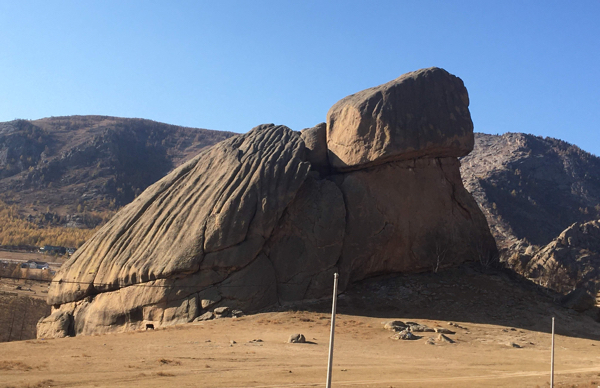 It was just a short distance down another gravel road, and Inka explained to me the story behind Turtle Rock and its cultural significance. Legend states Galdan Boshoghtu Khan hid all his treasures in a cave at Turtle Rock just before he was killed in battle in 1696. Galdan’s wife, Queen Anu, refused to leave the treasure and was also killed. The treasure remains hidden to this day.
It was just a short distance down another gravel road, and Inka explained to me the story behind Turtle Rock and its cultural significance. Legend states Galdan Boshoghtu Khan hid all his treasures in a cave at Turtle Rock just before he was killed in battle in 1696. Galdan’s wife, Queen Anu, refused to leave the treasure and was also killed. The treasure remains hidden to this day.
The rock really does look like a turtle from one side. I have to say, however, I wasn’t all that impressed with the rock itself. From the other side, it doesn’t resemble a turtle at all. I was far more impressed with the legend and the prospect of hidden treasure. I don’t think we spent more than ten minutes here at the most. As a place to stop and take a quick photo while going to or from some place else, it’s fine. But as a destination alone…nope. Fortunately, it’s on the way to the Ariyaval Buddhist Meditation Temple, so no time was lost on the brief stop.
Ariyaval Buddhist Meditation Temple
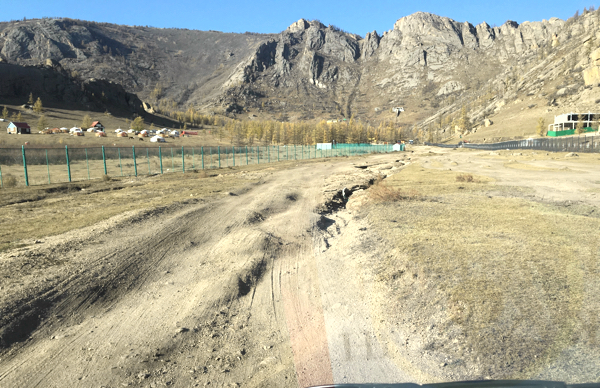 The temple is a short distance down the same gravel road, which quickly degraded into potholes, pits, and ruts. Inka explained the significance of the temple design as our driver carefully maneuvered around the road damage, driving at walking pace. The temple, she said, is designed in the shape of an elephant’s head. The 108 steps to the top represent an elephant’s extended trunk, one step for each ring in the elephant’s trunk. This information was all new to me, and I listened with great interest.
The temple is a short distance down the same gravel road, which quickly degraded into potholes, pits, and ruts. Inka explained the significance of the temple design as our driver carefully maneuvered around the road damage, driving at walking pace. The temple, she said, is designed in the shape of an elephant’s head. The 108 steps to the top represent an elephant’s extended trunk, one step for each ring in the elephant’s trunk. This information was all new to me, and I listened with great interest.
The temple itself is built into the side of a mountain. To get to it, we had to first climb the mountain, and then we had to ascend the 108 temple steps. The path up the mountain was lined with 144 signs, each featuring a different Buddhist quote. Fortunately, the mountain path was mostly paved. 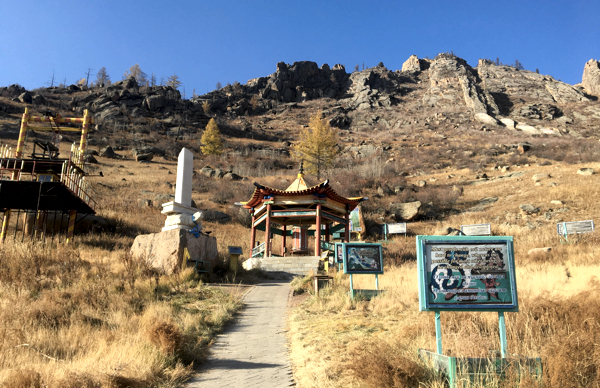 The first part of the climb, which was also the steepest part of the path, was comprised of shallow steps. I silently read the signs along the way. Two really stood out to me: “Do not use your precious human body only to digest and urine,” and “To praise the name of one who is unworthy is like hanging a bell on a cow with no milk.” The first one seems pretty obvious to me, and the second one because…. I’ll let you fill in the blanks, but Inka laughed and said she heard similar sentiments echoed from all of the Americans on her tours.
The first part of the climb, which was also the steepest part of the path, was comprised of shallow steps. I silently read the signs along the way. Two really stood out to me: “Do not use your precious human body only to digest and urine,” and “To praise the name of one who is unworthy is like hanging a bell on a cow with no milk.” The first one seems pretty obvious to me, and the second one because…. I’ll let you fill in the blanks, but Inka laughed and said she heard similar sentiments echoed from all of the Americans on her tours.
A gazebo marked the halfway point of the path. It was lined with bright red and yellow cylindrical prayer wheels. Inka showed me how to walk clockwise around the gazebo, spinning each of the wheels also clockwise for good luck.
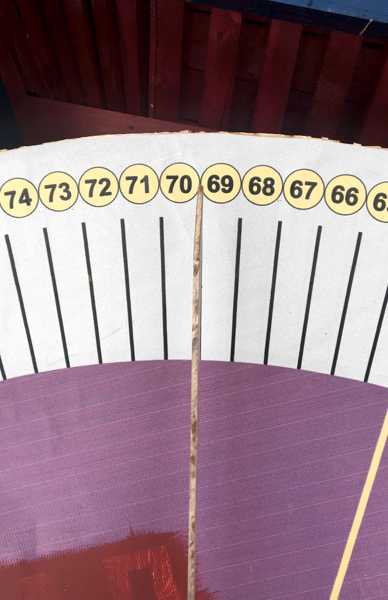 A large wheel with numbers stood in the center of the gazebo. This was also spun. According to tradition, whatever number the pointer landed on, that was your topic for meditation. The pointer stuck between 69 and 70 for me, so I’m not sure what that means.
A large wheel with numbers stood in the center of the gazebo. This was also spun. According to tradition, whatever number the pointer landed on, that was your topic for meditation. The pointer stuck between 69 and 70 for me, so I’m not sure what that means.
69: You should recognize the presence of dullness when the mind cannot see the object very clearly, when you feel as if you were blind or in a dark place or that you have closed your eyes.
70: If, while you are in meditation, you (sic) mind chases after qualities of external objects such as form, or turns its attention to other phenomenon, or is distracted by desire for an object you have previously experienced, or if you suspect distraction is approaching, reflect that all composite phenomena are impermanent. Think about suffering and so forth, topics that will temper the mind.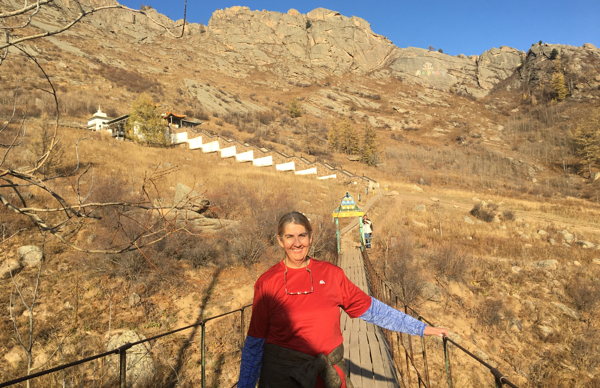
Uh…I pick 69.
The path leveled out a bit at this point, making the trek a bit easier. And then we came to a rickety old suspension walkway, hanging high above a ravine. Boards were loose and broken, and it swayed easily. However, reaching the temple meant all my sins would be forgiven, purifying my soul, Inka assured me, so I trusted in the gods to keep me safe, and crossed.
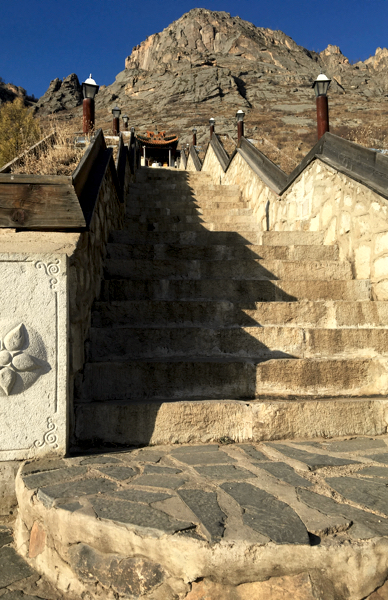 And that left only the 108 steps. I started climbing, one step at a time; at first, like a toddler, and then more upright as my confidence increased. Although it was really steep and the steps were really narrow, it wasn’t that bad. In no time, we were at the top, where we were greeted by a monk. Inka and I both turned around to check out the view. It was stunning. We could see for miles, all the way down the valley to Turtle Rock and Terelj Road and the mountains beyond.
And that left only the 108 steps. I started climbing, one step at a time; at first, like a toddler, and then more upright as my confidence increased. Although it was really steep and the steps were really narrow, it wasn’t that bad. In no time, we were at the top, where we were greeted by a monk. Inka and I both turned around to check out the view. It was stunning. We could see for miles, all the way down the valley to Turtle Rock and Terelj Road and the mountains beyond.
We admired the view for a few minutes, and then turned our attention to the temple. Inka pointed out the images of heaven and hell painted on the temple walls. The images of hell were disturbing. I had no idea the Buddhist religion had the concept of a hell. We walked around the temple, clockwise, of course, and Inka pointed out various gods and their significance. Again, more prayer wheels. The temple contains 108 of them. We spun them as we walked around the building, admiring the intricate artwork.
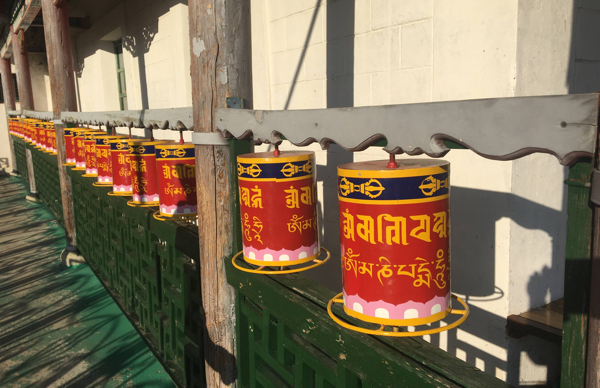 It’s customary to remove one’s shoes when entering a Buddhist temple, but a basket of shoe covers sat next to the door for us tourists. Inka and I each slipped on a pair before heading inside. It was absolutely stunning, even more so than outside. Every surface was carved and/or painted with symbolic meaning. The walls contained murals of various gods, and the front of the temple had slots containing meditation scripts, icons, and other artifacts. Inka pointed out the various differences in the gods’ postures and explained what it meant. The colors and images were a little overwhelming. After a thorough tour of the inside, we made sure to walk backwards out of the temple, keeping our faces to the gods so that we didn’t make them angry. We didn’t need to deal with angry gods!
It’s customary to remove one’s shoes when entering a Buddhist temple, but a basket of shoe covers sat next to the door for us tourists. Inka and I each slipped on a pair before heading inside. It was absolutely stunning, even more so than outside. Every surface was carved and/or painted with symbolic meaning. The walls contained murals of various gods, and the front of the temple had slots containing meditation scripts, icons, and other artifacts. Inka pointed out the various differences in the gods’ postures and explained what it meant. The colors and images were a little overwhelming. After a thorough tour of the inside, we made sure to walk backwards out of the temple, keeping our faces to the gods so that we didn’t make them angry. We didn’t need to deal with angry gods!
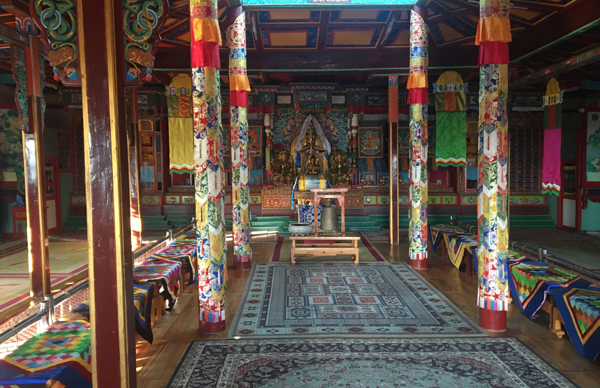 By the time we left the temple, the sun was beginning to set. Fortunately, it was all downhill to the van as I was pretty tired and a little unsteady on my feet. But, what a day! It was without a doubt one of the best days of my life.
By the time we left the temple, the sun was beginning to set. Fortunately, it was all downhill to the van as I was pretty tired and a little unsteady on my feet. But, what a day! It was without a doubt one of the best days of my life.
We drove back to the city, and I got to see what Inka meant by Ulaanbaatar rush hour traffic. It was worse than Seattle traffic! It took three hours to drive the 100km back, and we reached the hotel at 8:30 p.m.
Modern Nomads Restaurant
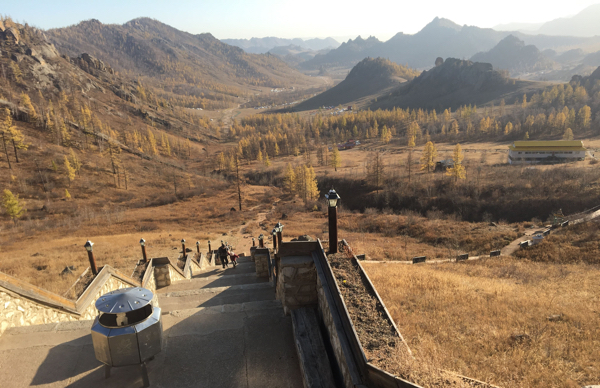 I was pretty beat and also hungry as I really hadn’t eaten that much that day, so I walked across the street to Modern Nomads, one of Mongolia’s swankiest chain restaurants. I wanted to celebrate, and I had read about this restaurant online; it had a good reputation, and I was eager to try traditional Mongolian food. The restaurant looked like any typical modern restaurant back in the US, except with Mongolian decorations. And, it was packed. Fortunately, there was one table available, so I didn’t have to wait to be seated.
I was pretty beat and also hungry as I really hadn’t eaten that much that day, so I walked across the street to Modern Nomads, one of Mongolia’s swankiest chain restaurants. I wanted to celebrate, and I had read about this restaurant online; it had a good reputation, and I was eager to try traditional Mongolian food. The restaurant looked like any typical modern restaurant back in the US, except with Mongolian decorations. And, it was packed. Fortunately, there was one table available, so I didn’t have to wait to be seated.
The wait staff spoke no English, but the menu was in both English and Mongolian, so I just pointed at what I wanted. I ordered ice tea, and the waiter brought me a kiwi ice tea, which I’m pretty sure contains alcohol, but it was delicious, anyway. I also ordered a traditional (according to the menu) beef noodle soup and main dish that featured a sampler of (according to the menu) traditional foods.
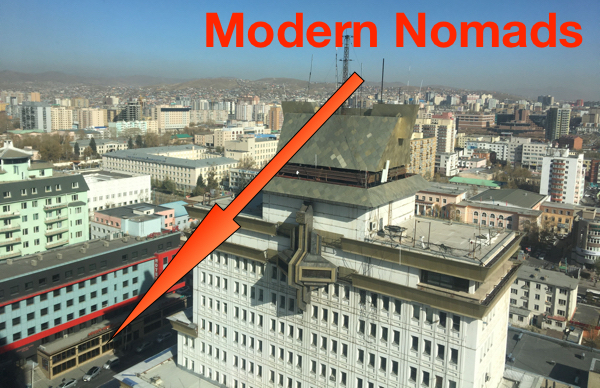 The soup was amazing! Rather than the broth containing noodles, instead it was covered with a single large noodle, similar to the cheese on a French onion soup. I used my knife to cut around the edges and then cut it up into bite size pieces so I could eat it. It was wonderful and soft and tasted freshly made.
The soup was amazing! Rather than the broth containing noodles, instead it was covered with a single large noodle, similar to the cheese on a French onion soup. I used my knife to cut around the edges and then cut it up into bite size pieces so I could eat it. It was wonderful and soft and tasted freshly made.
The main dish had four different types of traditional dumplings. I know one was buuz, and another might have been lamb eyeballs or testicles; I’m not sure. (Just kidding!) I should have paid more attention to the menu; I guess I was just too tired. I wouldn’t say it was delicious, but it was, at least, interesting. It was pretty much the same type of meat, wrapped in the same type of pastry (more like the large noodle that was in the soup, rather than what we might think of as pastry), and then shaped and cooked differently. Other than the way each looked, the four were pretty much the same. I ended dinner with a slice of triple chocolate cake. Total bill: ₮43,575, or US$16.30.
After that, I headed back to my hotel, and I must have been really super tired because all I remember next is waking up the following morning.
